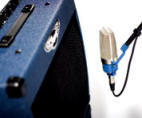 Yesterday, I described a simple modification on the Apex 205 ribbon mic. To show the results of the mod, I recorded samples using both the modded 205 and a stock version of the same mic.
Yesterday, I described a simple modification on the Apex 205 ribbon mic. To show the results of the mod, I recorded samples using both the modded 205 and a stock version of the same mic.
Methodology
I recorded each pair of clips below simultaneously, which makes A/B comparison easy: Line up the beginning of both clips in your DAW, and flip between them while they play. I choose this over a standard “before and after” approach because the performance in each pair of clips is identical, which makes it easier to concentrate on the sonic differences without being distracted by performance nuances.
I should note that this approach makes two assumptions:
- The unchanged stock mic ribbon has the same response as the modded mic ribbon: I’ve used these mics as a stereo pair in the past, so I know they were, for all purposes, identical. (In hindsight, I should have recorded an A/B clip with both mics before modding one, for comparison.)
- Phase anomalies are minimal: It’s impossible to completely eliminate phase effects when dealing with multiple mics. However, I took care to ensure the ribbon of each mic was exactly the same distance from the sound source. You can load the WAV files in a DAW yourself and confirm that the transients strike each mic coincidentally. Further, the characteristics of each mic are consistent across the samples below, even though I recorded different instruments, with different configurations. So it’s reasonable to assume that audible differences are due to the microphones’ properties rather than my recording setup.
Before / After Clips
I tried to represent both musical and percussive sources, as well as fast and slow transients. Note, though, that I haven’t applied any post-processing to the sounds. They’re rough … but accurate.
If you have difficulty hearing differences between each pair of clips, import the WAV files into your DAW, line them up to start together, loop a small section, and listen to each file 3 or 4 times before switching to the other. As your ears adapt to the similarities between each clip, the differences will become more obvious.
Acoustic Guitar – Hard strummed
This sample is both percussive and musical, to highlight differences in the modded mic’s transient response, as well as its broadband frequency response. Listen particularly to the lower frequencies.
Stock mic – Acoustic guitar strummed [2.6Mb]
Modded mic – Acoustic guitar strummed [2.6Mb]
Acoustic Guitar – Finger picked
This sample has much slower transients than above. Notice how the modded mic sample sounds less restricted.
Stock mic – Finger picked guitar [2.4Mb]
Modded mic – Finger picked guitar [2.4Mb]
Cymbals (crash, then ride)
In this sample, focus on the high frequencies. I find the differences obvious in the cymbal decay, where the stock mic exhibits some high frequency distortion. (Not necessarily a bad thing for a cymbal mic. In fact, I’d probably prefer the stock mic here for close-miking a hi hat.)
Stock mic – Cymbals [3.8Mb]
Modded mic – Cymbals [3.8Mb]
Electric Guitar
I played this on a Les Paul through a Peavey Classic 50 almost fully cranked, with just a hint of saturation. Personally, I think this sample illustrates the best use of a cheap ribbon mic: Loud guitar! The differences between each sample, though, are minimal.
Stock mic – Electric guitar [2.3Mb]
Modded mic – Electric guitar [2.3Mb]
Full Drum Kit
Finally, here’s a full drum kit sample. Listen for differences in the low bass (especially the kick drum,) and cymbal tails.
Stock mic – Full kit [3Mb]
Modded mic – Full kit [3Mb]
Observations
I wouldn’t call the change night and day. This mod certainly won’t turn an Apex or Nady into a Royer. But given the minimal effort required, I’d say there’s no question the mod is worthwhile.
As I noted, the changes to the mic’s response are most obvious at the ends of the frequency spectrum. The moded mic has a beefier bottom end, and a softer top end. Through the modified mic, acoustic guitar has clearer low-mids, kick drum has much more punch, and cymbal tails are a little less brash. High frequencies through the stock mic almost sound distorted in comparison.
Overall, the modded mic yields a slightly richer, less “pinched” sound.
Next, my Closing thoughts which you might find helpful if you’d like to try modding your own ribbon mic (even if it’s not an Apex 205)
Previously: Ribbon Mic Mod – Part 1
For more DIY, microphone, and home recording tips,
Subscribe to the Hometracked feed, or receive email updates.
Tags: before&after, diy, microphones

1 comment
Trackback URI Comments feed for this article
One of the things that Fum (his screenname) of Shinybox fame says is that the biggest difference is made by changing out the transformer. EDCOR USA makes a pretty good (by all accounts) ribbon mic transformer for a very nice price:
http://edcorusa.com/products/transformers/rmx/rmx1.html
At that price, it’s worth trying out to see what happens, I think. That’s probably what I’ll end up doing.